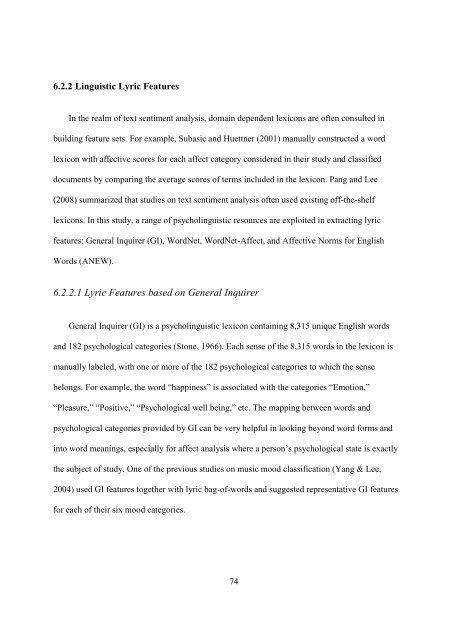improving music mood classification using lyrics, audio and social tags
improving music mood classification using lyrics, audio and social tags
improving music mood classification using lyrics, audio and social tags
Create successful ePaper yourself
Turn your PDF publications into a flip-book with our unique Google optimized e-Paper software.
6.2.2 Linguistic Lyric Features<br />
In the realm of text sentiment analysis, domain dependent lexicons are often consulted in<br />
building feature sets. For example, Subasic <strong>and</strong> Huettner (2001) manually constructed a word<br />
lexicon with affective scores for each affect category considered in their study <strong>and</strong> classified<br />
documents by comparing the average scores of terms included in the lexicon. Pang <strong>and</strong> Lee<br />
(2008) summarized that studies on text sentiment analysis often used existing off-the-shelf<br />
lexicons. In this study, a range of psycholinguistic resources are exploited in extracting lyric<br />
features: General Inquirer (GI), WordNet, WordNet-Affect, <strong>and</strong> Affective Norms for English<br />
Words (ANEW).<br />
6.2.2.1 Lyric Features based on General Inquirer<br />
General Inquirer (GI) is a psycholinguistic lexicon containing 8,315 unique English words<br />
<strong>and</strong> 182 psychological categories (Stone, 1966). Each sense of the 8,315 words in the lexicon is<br />
manually labeled, with one or more of the 182 psychological categories to which the sense<br />
belongs. For example, the word “happiness” is associated with the categories “Emotion,”<br />
“Pleasure,” “Positive,” “Psychological well being,” etc. The mapping between words <strong>and</strong><br />
psychological categories provided by GI can be very helpful in looking beyond word forms <strong>and</strong><br />
into word meanings, especially for affect analysis where a person’s psychological state is exactly<br />
the subject of study. One of the previous studies on <strong>music</strong> <strong>mood</strong> <strong>classification</strong> (Yang & Lee,<br />
2004) used GI features together with lyric bag-of-words <strong>and</strong> suggested representative GI features<br />
for each of their six <strong>mood</strong> categories.<br />
74
















